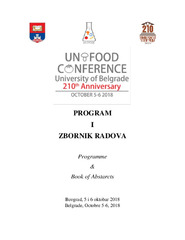Prikaz osnovnih podataka o dokumentu
Antioxidative potential of the Oyster mushroom (Pleurotus ostreatus) cultivated on grape pomace and straw supstrate
| dc.creator | Doroški, Ana | |
| dc.creator | Kozarski, Maja | |
| dc.creator | Klaus, Anita | |
| dc.creator | Nikšić, Miomir | |
| dc.creator | Vunduk, Jovana | |
| dc.creator | Djekic, Ilija | |
| dc.date.accessioned | 2023-11-29T09:17:44Z | |
| dc.date.available | 2023-11-29T09:17:44Z | |
| dc.date.issued | 2018 | |
| dc.identifier.isbn | 978-86-7522-060-2 | |
| dc.identifier.uri | http://aspace.agrif.bg.ac.rs/handle/123456789/6507 | |
| dc.description.abstract | Oxidative stress caused by an imbalanced metabolism and an excess of reactive oxygen species (ROS) lead to a range of health disorders. Synthetic antioxidants can improve defence mechanisms, but their potential adverse toxic effects give priority to natural antioxidants. Pleurotus ostreatus (Jacq. ex Fr.) P. Kumer (1871) (oyster mushroom) is one of the most commonly cultivated mushrooms in the world due to its adaptibility to various substrates and having a specific mild taste of oyster in culinary processing. Because of the presence of various active ingredients it owns antidiabetic, antibacterial, anticholestrolic, antiarthritic, antioxidant, anticancer and antiviral activities. The aim of this study was to monitor the influence of grape pomace supstrate on the antioxidative potential of oyster mushroom, as well as changes of antioxidant properties from the day of harvesting during the storage period of 7 and 14 days. The substrate used for cultivation of Pleurotus ostreatus was consisted of grape pomace and straw (20:80%) The fruiting bodies were air-dried at 55°C, powdered and then prepared as crude hot water extracts in mild conditions, at 75-85°C for 1.5 h. Concentration range of 0.625-40 mg/mL of each extract was analyzed. The radical absorbance ability of the extract was tested in vitro, using DPPH free radical and ABTS+ radical scavenging capability and expressed as EC50 (mg/mL) values. Crude water extracts showed the following results: EC50 values of the DPPH scavenging ability on the 0th, 7th and 14th day were 30.25, 29.24 and 19.9 mg/mL, respectively. EC50 values of the ABTS+ scavenging activity of the extracts on the 0th, 7th and 14th day showed the difference, with following values: 8.1, 8.5 and 2.6 mg/mL, respectively. All investigated extracts showed good antioxidant abilities. Both methods confirmed decrease of the EC50 values and increasing of the antioxidative potential from harvesting day and during the storage period of 7 and 14 days. | sr |
| dc.language.iso | en | sr |
| dc.publisher | Univerzitet u Beogradu / University of Belgrade | sr |
| dc.relation | info:eu-repo/grantAgreement/MESTD/inst-2020/200116/RS// | sr |
| dc.rights | openAccess | sr |
| dc.rights.uri | https://creativecommons.org/licenses/by/4.0/ | |
| dc.source | UNIFOOD CONFERENCE University of Belgrade 210th Anniversary | sr |
| dc.title | Antioxidative potential of the Oyster mushroom (Pleurotus ostreatus) cultivated on grape pomace and straw supstrate | sr |
| dc.type | conferenceObject | sr |
| dc.rights.license | BY | sr |
| dc.identifier.fulltext | http://aspace.agrif.bg.ac.rs/bitstream/id/25008/Antioxidative_potential_of_2018.pdf | |
| dc.identifier.rcub | https://hdl.handle.net/21.15107/rcub_agrospace_6507 | |
| dc.type.version | publishedVersion | sr |


